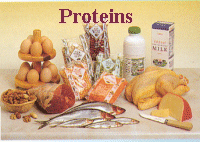Biochemistry

Biochemistry is the study of living systems. Important discoveries about how life is maintained and how diseases occur are being made every day by biochemists.
Proteins

All of the products shown above contain a high source of protein.
Proteins, a class of natural polymers, make up about 15% of our bodies and have molecular weights that rande from approximately 6000 to over 1000000 grams per mole. Proteins perform many functions in the human body. Fibrous proteins provide structural integrity and strength for many types of tissue and are the main components of muscle, hair, and cartilage.
Carbohydrates
Carbohydrates serve as a food source for most organisms and as a structural material fo plants. Most important carbohydrates, such as starch and cellulose, are polymers composed of monomers called monosaccharides, or simple sugars.
Nucleic Acids
DNA is the basic hereditary material in all cells and contains all the information necessary to make proteins.
|
DNA is a linear polymer
that is made up of nucleotide units. The nucleotide unit consists of a
base, a deoxyribose sugar, and a phosphate. There are four types of
bases: adenine (A), thymine (T), guanine (G), and cytosine (C), as shown
on your left. Each base is connected to a sugar via a ß glycosyl
linkage. The nucleotide units are connected via the O3' and O5' atoms
forming phosphodiester linkages.
In normal DNA, the bases form pairs: A to T and G to C. This is called complementarity. A duplex of DNA is formed by two complementary chains that are arranged in an anti-parallel manner. The results of fiber and single crystal x-ray crystallographic studies have shown that DNA can have several conformations. The most common one is called B-DNA. B-DNA is a right-handed double helix with a wide and narrow groove. Tha bases are perpendicular to the helix axis. DNA can also be found in the A form in which the major groove is very deep and the minor groove is quite shallow. A very unusual form of DNA is the left-handed Z-DNA. In this DNA, the basic building block consists of two nucleotides, each with different conformations. Z-DNA forms excellent crystals. Several years ago it was discovered that nucleic acids can form four stranded structures and a few examples of these molecules now exist. Occasionally mutations occur in which a base is changed. Base pairs still form, but they are not in the usual Watson-Crick geometry. Examples of these mismatches have been characterized. Very recently, DNA structures have appeared that are very unusual in that the end pairs are flipped out or there are bulges.
| ||
RNA

DNA serves as the template for the synthesis of RNA.
| RNA is a polymer that
contains ribose rather than deoxyribose sugars. The normal base
composition is made up of guanine, adenine, cytosine, and uracil.
| ||
Another very interesting type of RNA is called a ribozyme, which is an RNA that has catalytic activity. Recently, several ribozyme structures have been characterized.
Lipids
|
Corn seed embryo: root meristem cells exibiting dense staining lipid bodies |
Lipids are a broad class of organic products found in living systems. Most are insoluble in water, but soluble in nonpolar solvents. The definition excludes the mineral oils and other petroleum products obtained from fossil material. Major classes of lipids include the fatty acids , the glycerol-derived lipids (including the fats and oils and the phospholipids ), the sphingosine-derived lipids (including the ceramides, cerebrosides, gangliosides, and sphingomyelins), the steroids and their derivatives, the terpenes and their derivatives, certain aromatic compounds, and long-chain alcohols and waxes . In living organisms lipids serve as the basis of cell membranes and as a form of fuel storage. Often lipids are found conjugated with proteins or carbohydrates, and the resulting substances are known as lipoproteins and lipopolysaccharides. The fat-soluble vitamins can be classified as lipids. Liposomes are spherical vesicles formed by mixing lipids with water or water solutions. They have found applications in the oral administration of some drugs (e.g., insulin and some cancer drugs), since they retain their integrity until they are broken down by the lipases in the stomach and small intestine.
|